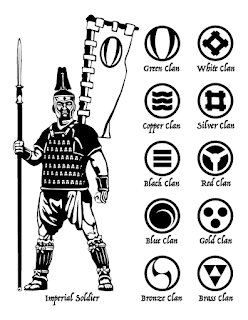To demonstrate how useful this is, take a look at how I have plugged in the Ten Clans from my last post, where I posited a campaign world based on using only four of the twelve available 5e classes:
The Poison Faction is friendly with the Lightening Faction and has enmity toward the Fire Faction:
- The Green Clan specifically likes the Bronze Clan and hates the Gold Clan
- The Green Clan has also convinced elements of the Red Clan to betray the Fire Faction. This traitorous element specifically likes the Blue Clan and hates the Brass Clan
The Lightening Faction is friendly with the Fire Faction and has enmity toward the Acid Faction:
- The Bronze Clan specifically likes the Gold Clan and hates the Black Clan
- The Blue Clan specifically likes the Brass Clan and hates the Copper Clan
The Fire Faction is friendly with the Acid Faction and has enmity toward the Cold Faction:
- The Gold Clan specifically likes the Black Clan and hates the White Clan
- The Brass Clan specifically likes the Copper Clan and hates the Silver Clan
The Acid Faction is friendly with the Cold Faction and has enmity toward the Poison Faction:
- The Blue Clan specifically likes the White Clan and hates the Green Clan
- The Copper Clan specifically likes the Silver Clan and hates the Red Clan
The Cold Faction is friendly with the Poison Faction and has enmity toward the Lightening Faction:
- The White Clan specifically likes the Green Clan and hates the Bronze Clan
- The Silver Clan specifically likes the Red Clan and hates the Blue Clan
By simply plugging in these factions into the Wu Xing model, all kinds of interesting relationships and conflicts arise. This becomes especially useful when planning a campaign full of political intrigue.
And because I love doing it, here is some heraldry for the Ten Clans:


No comments:
Post a Comment